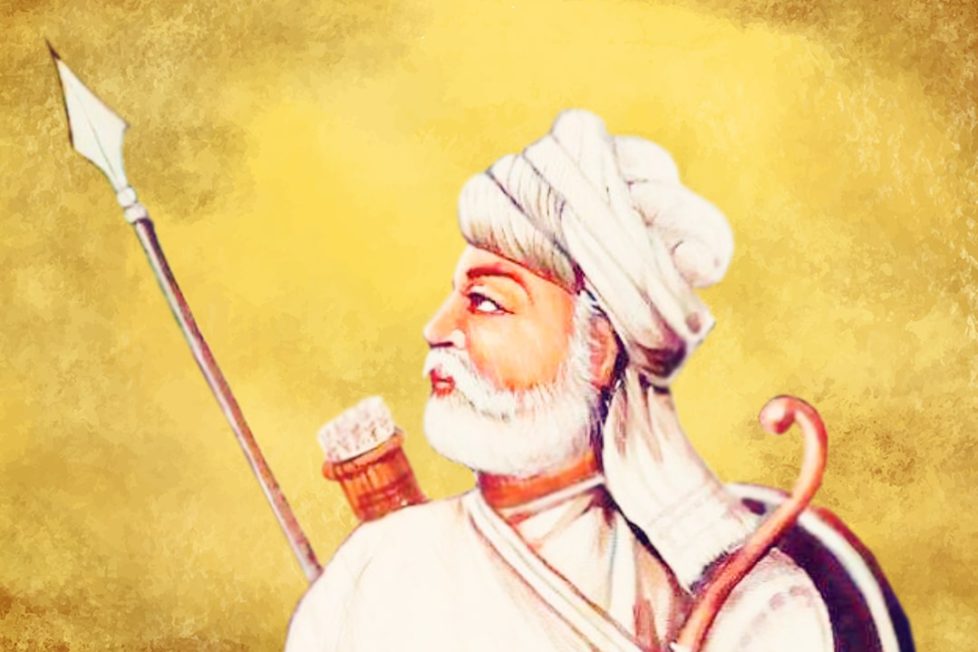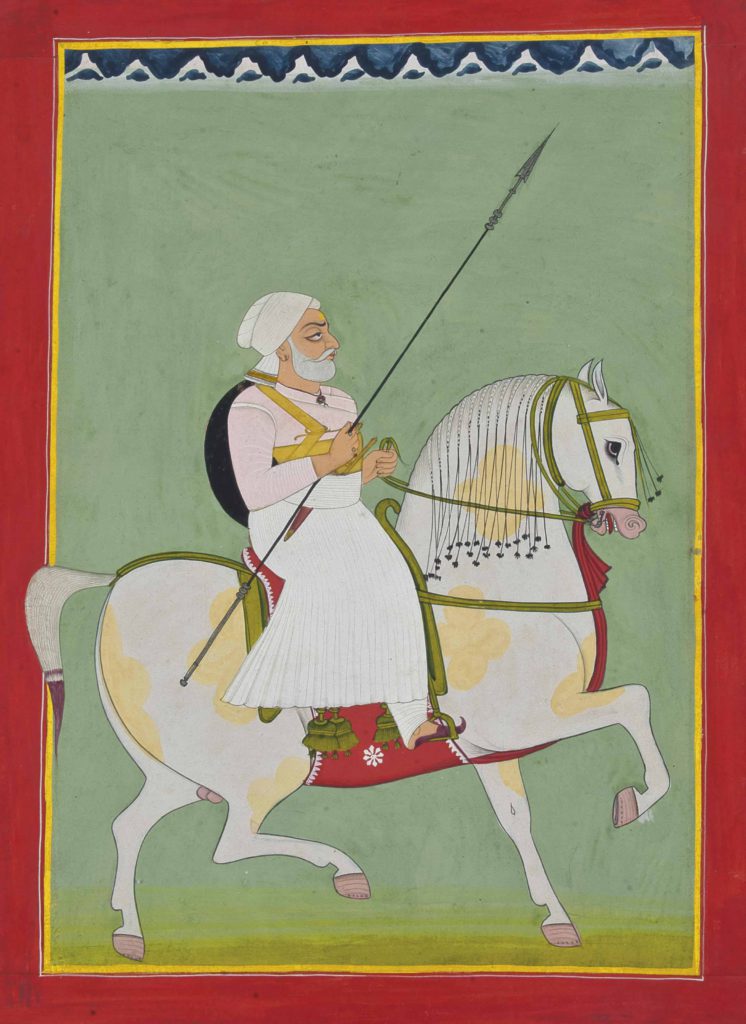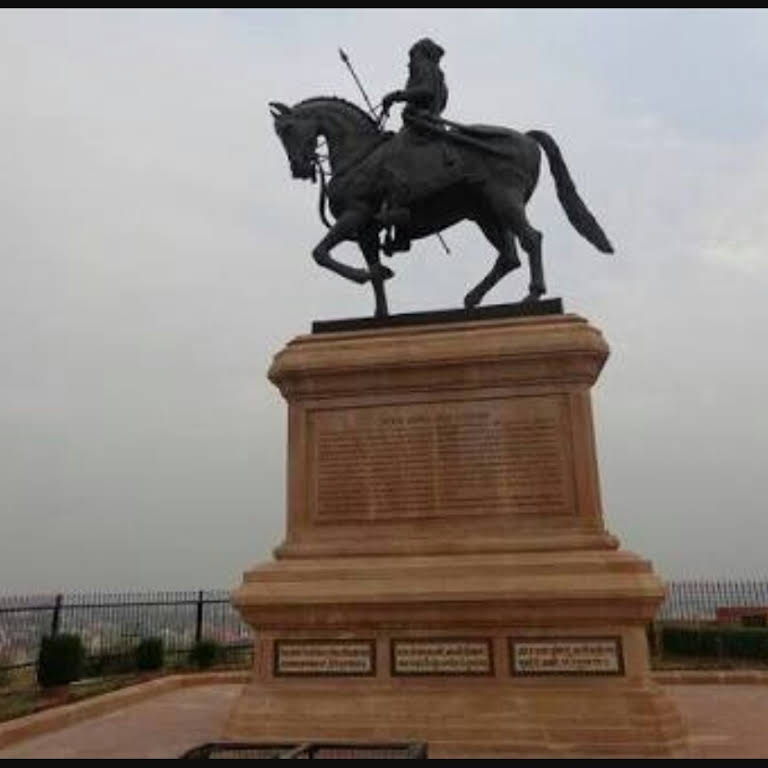Veer Durgadas Rathore


माई ऐड़ा पूत जन, जेड़ा दुर्गादास,
बाँध मुंडासे राखियो, बिन थांबे आकाश! Mother, give birth to a son just like Durgadas,
Who stopped the flooding dam of the Moghuls without any support.
Veer Durgadas was one of the chieftains of Jaswant Singh, the King of Jodhpur, when Aurangzeb ruled Delhi. The king developed some disease and was to die of it. He was young at the time and his son, Ajeet Singh, was still a suckling infant. Jaswant Singh knew in his heart that the rest of the greedy chieftains would kill Ajeet Singh the moment he would die. Hence, he was very restless on his death bed!
It is here that a young Durgadas approached the dying king and asked him the reason for his restlessness! Jaswant Singh told Durgadas of his fears and said that he is unable to die in peace because of it.
Veer Durgadas collected a few of the trusted chiefs loyal to the King and swore on Mother Jagadamaba to protect the family of the king as long as even one of them were alive. Trusting the custody of his toddler with Veer Durgadas, Jaswant Singh bid adieu to the mortal world!
Those were very treacherous and tricky times. There were people who wanted to join hands with the Moghuls and take over the reins of the Kingdom of Marwar (Jodhpur). No one could be trusted! Then Aurangzeb himself wanted to merge Jodhpur into the Moghul empire under the pretext that Ajeet Singh was an infant.
Durgadas created a network of espionage and counter espionage to keep himself informed about every move of the locals as well as the Mughals. It was this extremely tricky and intelligent foresight that kept Durgadas ahead of the enemies of the State of Marwar!
Aurangzeb, with the support of other Rajput chiefs who were jealous of the erstwhile King and Durgadas, annexed Jodhpur and took the child Ajeet Singh into custody. Durgadas, with the Thakur of Balunda (a small principality in Marwar), planned the escape of young Ajeet Singh from the clutches of the Mughals.
With Durgadas there was a poet warrior (known as a Chaaran), Jadaaw ji, who dressed up like a snake charmer and went into the palace where Ajeet Singh was being kept. Jadaaw ji hid little Ajeet in a basket and took him out of the palace. The Mughal army immediately went out in their pursuit, and the escape happened quite in the Bollywood style! 10-15 valorous Rajputs would stay behind to engage the Moghuls and thus provide time for Durgadas and Ajeet Singh to gain some distance. All the warriors would be slain and then the pursuit would resume. In the end, Durgadas, Thakur Mokham Singh of Balunda, Jadaaw ji, and seven other horsemen were all that managed to reach the safety of Marwar, and kept Ajeet Singh in Balunda till his teenage.
Durgadas continued inflicting heavy damages on the Moghuls by engaging them in relentless guerrilla warfare!

With Aurangzeb growing old, and his grip on power loosening, a war of succession broke out between his children. Durgadas supported one of his sons, Akbar, in the war of succession. Akbar died of some disease and Aurangzeb asked Durgadas that his daughter-in-law and grandchildren be returned to him. Durgadas, the man that he was, returned the lady and her children to Aurangzeb!
Aurangzeb is supposed to have asked his daughter-in-law: कैसा दिखता है वो चूहा?
— How does the rat look?
The daughter-in-law replied: कैसा दिखता है? जहाँपनाह, जोधपुर में उन्हें बाबोसा कहा जाता है. और किसी की हिम्मत कहाँ कि उनसे नज़र मिला के उनकी तरफ देख सके! हमने तो सिर्फ उनकी रोबदार आवाज़, या जूतियों की आहट ही सुनी है !
— How does he look? He is called “babosa” in all Jodhpur. None dares look him in the eyes. I have heard only his strong voice or the sound of his footfalls.
For a barbarian like Aurangzeb, it was inconceivable that his daughter-in-law would have remained untouched in custody, but Veer Durgadas was a man of such integrity and honor that he never even looked at the Moghul princess!
This was the unwritten code for the worshippers of Shakti — to respect and protect the honor of women, even if they belonged to the enemy camp! Such decency in times when it was a done thing to have the women of the opposite camp for yourself.
आठ पहर चौबीस घडी, घुडले ऊपर वास।
सैल अणि सूं सेकतो, बाटी दुर्गादास ॥ Riding on horseback, days and nights would pass!
On the rough terrain of the Aravalis,
Durgadas baked flour balls with the tip of his spear!
For a good 20-25 years, Durgadas kept on fighting from the hills of Sirohi and Pali. In 1707, Aurangzeb died. This was an opportune time for Durgadas and he attacked Jodhpur and took control of Jodhpur after a little resistance from the disarrayed Mughal Army.
Here is where we see the actual greatness of Durgadas and his real character. There have been many warriors in Rajasthan who fought for defending their land and women but we know of only one Durgadas who fought for concepts as abstract as loyalty and religion.
On annexing Jodhpur, he did the coronation (rajyabhisheka) of Ajeet Singh and fulfilled the promise he had made to his father Jaswant Singh. He could have easily eliminated Ajeet Singh and become the King himself, but he chose to remain loyal to his word and gave the kingdom effortlessly to Ajeet Singh! Nowhere in history can we find such unflinching loyalty to his motherland and such absolute detachment from power as in the life and deeds of Veer Durgadas Rathore !
Alas, if we Hindus had learned and drawn inspiration from this soul, the history of this subcontinent would have been entirely different! Instead of an unending saga of humiliating defeats at the hands of any and everyone who managed to cross the Indus, we would have been a proud race, unyielding in our honor and self-respect!
सिंघां देस विदेस सम, सिंघां किशा वतन्न ।
सिंह जिका वन संचरे, सो सिंघां रा बन्न ॥ Homeland or a foreign land is the same for lions!
What nation can contain a lion?
Whichever land he wanders into, that land belongs to the lion!
Final chapter of Durgadas’s life. Tragic, but also, one that raises Durgadas to sublime heights! Sometimes, I find it difficult to believe that we Hindus are the progeny of such noble souls !
Once Durgadas crowned Ajeet Singh the king of Jodhpur, he relegated himself to the background, largely spending his time and energy in rebuilding temples destroyed during the Moghul reg But he also helped Ajeet Singh tighten his grip on his regime. Then things happened, as has always been the misfortune of this great land of ours. Ajeet Singh, probably as a consequence of his insecure childhood or his below average mind, got jealous and suspicious of Veer Durgadas, the very man because of whom he was alive!
Though largely metaphorical, there is a story that once Ajeet Singh is supposed to have said to Durgadas..”बाबोसा, आप म्हारे हामी मति बैठिया करो !” — Old man, you must not sit in front of me in the Durbaar .
When Durgadas gave him a questioning look, Ajeet said ..”आपने देखूं तो मने विखा रा दिन याद आवे !” — When I see you, I am reminded of the days of my deprivation! So much for the wisdom and grace of our erstwhile rulers!
Durgadas endured such insults off and on, just for the sake of his loyalty to his motherland, till one day Ajeet Singh’s yes-men convinced him to do away with Durgadas altogether.
Durgadas got the whiff of the plans and the day he was to be murdered, he approached the King in the Durbaar and spoke aloud — I had procured a lot of gold in the battles of South India. I am an old man now, I want to gift you the gold and retire!
Ajeet Singh indicated to his point man to refrain from killing Durgadas, and then an appointment was fixed for Durgadas and Ajeet Singh to meet in the outskirts of Jodhpur ….
Durgadas had asked 500 horsemen loyal to him to lay an ambush there. As soon as Ajeet Singh turned up, he was surrounded by the horsemen and Durgadas said to him: ऊंदरा, थूं मने मारेला? हूँ तुर्कों रे हाथ नी आयो, थूं मने मारेला? अगर थारा बाप ने वचन नी दियो वेतो तो अबार थारो माथो वाड देतो! थाने सोनो चावे? औ जोधपुर रो राज दियो नी थाने …अबे आगो जा ! — You rat ! You will kill me? I could not be contained by the Turks and you will kill me? Had I not promised your father to protect you, I would have beheaded you right now! And what more gold do you expect from me? I have given you the kingdom of Jodhpur! Now, get lost before I forget my promise to your father ..
Durgadas Rathore, well into his 70s, along with a few of his loyal friends, turned his back to his motherland and rode away into the sunset, never to return. Durgadas walked away from the land he had taken birth in, had nurtured with his blood and sweat for the sake of a vow he had made, his head held high, in honor and unflinching loyalty !
The lion of a man walked away after showing his prey his real worth! The eagle cast a final glance on the kingdom of Jodhpur, spread his wings, and took his flight into oblivion, leaving behind the dust to settle and the turkeys to flutter their noisy wings of mediocrity. The land of Marwar lost her only noble son to the backstabbings of lesser mortals!
From Jodhpur, Veer Durgadas went to stay in Udaipur. Then one day, the Maharana of Udaipur gifted watermelons to the camp of Durgadas. Upon receiving the watermelons, Durgadas immediately asked his men to pack up. When asked the reason, Durgadas replied, “The Maharana has sent us a message. Watermelon is called ‘matiro’ in Mewari. This can be also be understood as ‘mati’ (do not) and ‘ro’ (stay)!
Durgadas then went to Ujjain and lived an ascetic’s life with the locals there. On 22 November 1718, on the banks of the Kshipra river at Ujjain, aged 81 years, Veer Durgadas Rathore breathed his last, with only a handful of his loyal friends by his side to witness his departure.

The samadhi of Veer Durgadas lay in ruins for almost three centuries, till my grandfather, the late Thakur Akshay Singh Ratnu, went to Ujjain in the 1950s and wrote at least 300 letters to different organizations of Rajputs to rebuild the samadhi. Sometime in the 1980s, the present-day Maharaja of Jodhpur, Gaj Singh, a fine and compassionate soul, took the trouble to go to Ujjain and got the Jeernoddhar (renovation) done. Renamed the Chakrateertha, the samadhi of Durgadas was rebuilt in red sandstone.
DISCLAIMER: The author is solely responsible for the views expressed in this article. The author carries the responsibility for citing and/or licensing of images utilized within the text.
